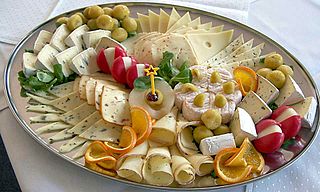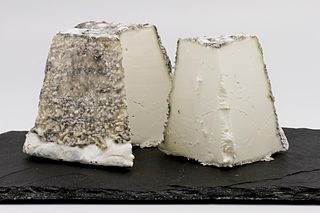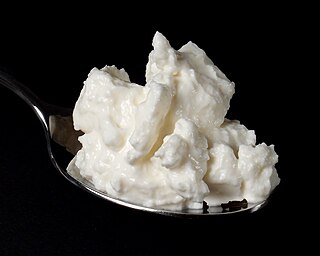
Brie is a soft cow's-milk cheese named after Brie, the French region from which it originated. It is pale in color with a slight grayish tinge under a rind of white mould. The rind is typically eaten, with its flavor depending largely upon the ingredients used and its manufacturing environment. It is similar to Camembert, which is native to a different region of France. Brie typically contains between 60% and 75% butterfat, slightly higher than Camembert.

Cabrales is a blue cheese made in the artisan tradition by rural dairy farmers in Asturias, Spain. This cheese can be made from pure, unpasteurized cow’s milk or blended in the traditional manner with goat and/or sheep milk, which lends the cheese a stronger, spicier flavor.

Gorgonzola is a veined protected designation of origin (PDO) Italian blue cheese, made from unskimmed cow's milk. It can be buttery or firm, crumbly and quite salty, with a "bite" from its blue veining. Outside the European Union and the countries recognizing the geographical origin protection, the name Gorgonzola can legally be used for similar cheeses, with only the full Italian name unambiguously referring to PDO Gorgonzola. It is a famously pungent cheese.

Goat cheese, goat's cheese or chèvre is cheese made from goat's milk. Goats were among the first animals to be domesticated for producing food. Goat cheese is made around the world with a variety of recipes, giving many different styles of cheeses, from fresh and soft to aged and hard.

Camembert is a moist, soft, creamy, surface-ripened cow's milk cheese. It was first made in the late 18th century in Camembert, Normandy, in northwest France. It is sometimes compared in look and taste to brie cheese, albeit with a slightly lower butterfat content than brie's typical 20% – 25% by weight.

Reblochon is a soft washed-rind and smear-ripened French cheese made in the Alpine region of Haute-Savoie from raw cow's milk. It has its own AOC designation.

Emmental, Emmentaler, or Emmenthal is a yellow, medium-hard cheese that originated in the Emme valley, Switzerland. It is classified as a Swiss-type cheese.

Milbenkäse, called Mellnkase in the local dialect and often known as Spinnenkäse, is a German speciality cheese. It is made by flavouring balls of quark with caraway and salt, allowing them to dry, and then leaving them in a wooden box containing rye flour and cheese mites for about three months. An enzyme in the digestive juices excreted by the mites causes the cheese to ripen. Milbenkäse tastes similar to Harzer cheese, but with a bitter note and a zesty aftertaste. Mites clinging to the cheese rind are consumed along with the cheese.

Acid-set or sour milk cheese is cheese that has been curdled (coagulated) by natural souring, often from lactic acid bacteria, or by the addition of acid. This type of cheese is technologically simple to produce.

Harzer cheese is a German sour milk cheese made from low fat curd cheese, which originates in the Harz mountain region south of Braunschweig.

Cambozola is a cow's milk cheese that is a combination in style of a French soft-ripened triple cream cheese and Italian Gorgonzola.

Liptauer is a spicy cheese spread from Slovak, Austrian and Hungarian cuisine. Liptauer is made with sheep milk cheese, goat cheese, quark, or cottage cheese.

Neufchâtel is a soft, slightly crumbly, mold-ripened, bloomy-rind cheese made in the Neufchâtel-en-Bray region of Normandy. One of the oldest kinds of cheese in France, its production is believed to date back as far as the 6th century AD, in the Kingdom of the Franks. It looks similar to Camembert and Brie, with a dry, white, edible rind, but the taste is saltier and sharper. Unlike other soft-white-rinded cheeses, Neufchâtel has a grainy texture. It is usually sold in heart shapes but is also produced in other forms, such as logs and boxes. It is typically matured for 8–10 weeks and weighs around 100–600 g (3.5–21.2 oz).

Pont-l'Évêque is a French cheese, originally manufactured in the area around the commune of Pont-l'Évêque, between Deauville and Lisieux in the Calvados département of Normandy. It is probably the oldest Norman cheese still in production.

Coulommiers is a soft ripened cheese from Coulommiers, Seine-et-Marne, France. It is made from cow's milk, and is usually in the shape of a disc with white, bloomy, edible Penicillium candidum rind. When produced as an artisanal or "farmhouse" cheese from unpasteurized milk, it has some reddish blush in parts of the rind. The period of ripening when made of pasteurised whole milk is about four to six weeks. The fat content is 40 per cent.

Cheese is a type of dairy product produced in a range of flavors, textures, and forms by coagulation of the milk protein casein. It comprises proteins and fat from milk. During production, milk is usually acidified and either the enzymes of rennet or bacterial enzymes with similar activity are added to cause the casein to coagulate. The solid curds are then separated from the liquid whey and pressed into finished cheese. Some cheeses have aromatic molds on the rind, the outer layer, or throughout.

There are many different types of cheese. Cheeses can be grouped or classified according to criteria such as length of fermentation, texture, methods of production, fat content, animal milk, and country or region of origin. The method most commonly and traditionally used is based on moisture content, which is then further narrowed down by fat content and curing or ripening methods. The criteria may either be used singly or in combination, with no single method being universally used.

Quark or quarg is a type of fresh dairy product made from milk. The milk is soured, usually by adding lactic acid bacteria cultures, and strained once the desired curdling is achieved. It can be classified as fresh acid-set cheese. Traditional quark can be made without rennet, but in modern dairies small quantities of rennet are typically added. It is soft, white and unaged, and usually has no salt added.
Shifra cheese is an artisanal cheese made in Israel. It is soft and creamy and similar in taste and texture to Camembert cheese.






























